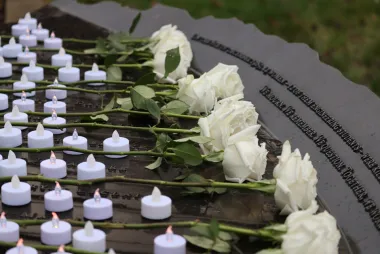Using technology to get ahead of wildfires
Predictive tools help communities respond quicker to wildfires and build resilience throughout the year

Wildfire season is no longer something that comes and goes; it’s becoming a year-round concern. In BC, wildfires can shape the entire year, and we want to know what’s coming, what’s at risk and how to prepare.
That’s why researchers at UBC Okanagan are using the latest data and technology to predict where and when wildfires may occur, rather than responding to them.
“The wildfires I see now aren’t the same wildfires I saw 10 to 15 years ago. They’re a different beast,” says Dr. Mathieu Bourbonnais, a former wildland firefighter who now conducts wildfire coexistence research at UBC Okanagan. “We’ve got to realize that new approaches are needed.”
UBC Okanagan’s wildfire research spans dozens of separate projects across multiple faculties, bringing together experts in engineering, environmental science, social sciences, Indigenous studies and more.

The data from Dr. Bourbonnais’ sensors feed into a live forecasting tool aimed at helping communities anticipate wildfire risk.
Through partnerships with emergency agencies, provincial ministries, communities and industry, the campus serves as a hub for applied, interdisciplinary solutions.
UBC Okanagan’s researchers and students are working year-round to help British Columbia adapt, prepare and live with wildfire.
Networking wildfires with technology
Dr. Bourbonnais and his team employ a network of sensors that monitor conditions such as heat, wind and humidity. That data feeds into forecasting tools that help communities anticipate risk to ensure lives, infrastructure and ecosystems are protected.
“This work isn’t just about emergency response,” says Dr. Bourbonnais. “One of the benefits of our sensor network—especially in partnership with BC Wildfire Service and the Kelowna Fire Department—is supporting prescribed burns. That’s where resilience begins.

Sensors like this monitor conditions like heat, wind and humidity.
“Cameras and tech alone don’t reduce risk unless we’re actively using them to manage the landscape and prevent disasters before they start.”
In a separate research project, Dr. Bourbonnais, BC Wildfire Service and the BC government are partnering on a provincial wildfire camera network.
Supported by a $200,000 provincial investment, the camera network will enable detection of smoke and flames using artificial intelligence, as well as provide real-time monitoring of active fires for wildfire and emergency management, and the public.

UBC Okanagan’s campus serves as the perfect testbed for a new sensor network that can detect fire-related hazards early.
Campus as a living lab
Dr. Qian Chen is fortunate that she doesn’t have to travel far to find research opportunities.
UBC Okanagan’s Smart Fire Detection Systems project is using the campus as a testbed to improve wildfire resilience through early hazard detection.
The research team is deploying thermal sensors, AI-driven monitoring and predictive algorithms to detect fire-related risks before they escalate.

Civil Engineering Professor Dr. Qian Chen.
By integrating real-time data into a decision-support dashboard, the system aims to help facility managers and emergency crews act quickly and effectively. The project combines engineering innovation with climate adaptation, offering scalable solutions for schools, hospitals and other critical infrastructure in high-risk regions.
The project treats UBCO as a living lab, working closely with UBC Okanagan staff to test the system in real conditions and ensure it meets the practical needs of those managing day-to-day fire safety.
“This is where research leaves the lab and makes a real difference,” Dr. Chen says. “The tools we’re developing here could eventually protect schools, hospitals, even entire neighbourhoods.”

Computer science students Shreya Saxena and schoolmate Archisha Mahendru are learning about climate resilience through hands-on project work.
Students of wildfire
Because the Okanagan campus itself is a research project, students are naturally given the chance to participate. They’re presented roles from collecting field samples to helping build interface designs for data analysis.
One of the students taking advantage of the opportunity is Shreya Saxena, a UBC Okanagan undergraduate student in computer science.
Through a work-study opportunity, Saxena contributed to Dr. Bourbonnais’s wildfire risk digital dashboard, building the interface that helps translate environmental data into clear, actionable insights.

Undergraduate student Saxena reviews the dashboard of a wildfire sensor project led by Dr. Bourbonnais. Her work helps turn raw data into real-time insights for frontline responders.
Her work is one example of how undergraduates at UBC Okanagan aren’t just learning about climate resilience in the classroom; they’re helping shape how it’s done in the field.
Together, research happening across the UBC Okanagan campus marks a shift—from reacting to fires to co-existing with them. It’s science rooted in care: for this place, future generations and everyone living in a hotter, drier world.
“Our goal was to make sure the right people have the right information at the right time,” Saxena says.



